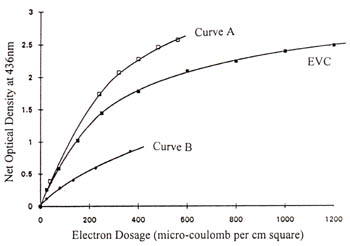|
The effect of retraces was eplained in CMI product information number 96-18 in light of the mechanism of e-beam darkening described therein.
Fig. 9 exhibits the transmittance spectra of the base glass plate 0.090" thick. The cut off in transmittance5 i.e., the absorption edge of the base glass is due to electronic transitions of the constituting chemical elements of the base glass. As the concentration of the doping with photo inhibitors increases, the absorption edge of the base glass shifts to longer wavelengths; namely %T of the base glass reduces in the spectral range of uv, then near uv and then blue light as the doping concentration of photo inhibitors increases. The concentration of photo inhibitors in the base glass composition of HEBS-glass was optimized for mercury G-line so that the HEBS-glass is totally inert to actinic radiation having wavelengths lambda equal to or longer than 436nm, and has a %T value of more than 88%, as shown in Fig 9; i.e., more than 96% in internal transmission for lambda >= 436nm (8% reflectance from two glass surfaces). See also Table 3. The values of %T and the internal transmission of the corresponding base glass 0.090" thick are more than 90% and more than 98% respectively for lambda >= 436nm (see also Table 3).
A standard HEBS-glass plate consists of two ion-exchanged surface glass layers, since both surfaces of a base glass plate were ion exchanged during a standard ion exchange process. To increase the transmittance of the HEBS-glass plate at lambda < 436nm one may grind off one ion exchanged surface glass layer and polish the now anhydrous surface to photomask quality. The transmittance spectra of the HEBS-glass plate 0.086" thick having only one ion changed surface is also shown in Fig 9.

Fig. 8. Net optical density at 436nm versus electron dosage at 20kv
Curve A -- MEBES III, 4000na 0.5µm address size, 40MHz
Curve B -- Cambridge EBMF 10.5, 25na, 0.1µm address size
EVC -- e-beam flood exposure
Previous Page / Next Page
|
| Wavelength (nm) |
base glass 0.090" (%T) |
HEBS-glass 2IEed Surface(%T) |
HEBS-glass 1IEed Surface(%T) |
Internal Transmittance of an IEed glass layer (%T) |
| 500.0 |
91.2 |
90.6 |
90.5 |
100 |
| 495.0 |
91.0 |
90.5 |
90.2 |
100 |
| 490.0 |
91.0 |
90.6 |
90.2 |
100 |
| 485.0 |
91.0 |
90.4 |
90.3 |
100 |
| 480.0 |
90.9 |
90.2 |
90.0 |
100 |
| 475.0 |
90.8 |
90.4 |
90.0 |
100 |
| 470.0 |
90.7 |
89.9 |
89.9 |
100 |
| 465.0 |
90.7 |
89.9 |
89.7 |
100 |
| 460.0 |
90.6 |
89.9 |
89.7 |
100 |
| 455.0 |
90.6 |
89.6 |
89.7 |
100 |
| 450.0 |
90.5 |
89.6 |
89.4 |
100 |
| 445.0 |
90.4 |
89.4 |
89.4 |
100 |
| 440.0 |
90.4 |
89.2 |
89.3 |
100 |
| 435.0 |
90.4 |
89.2 |
89.1 |
99.9 |
| 430.0 |
90.2 |
88.6 |
89.0 |
99.9 |
| 425.0 |
90.2 |
88.6 |
88.8 |
99.6 |
| 420.0 |
90.1 |
88.0 |
88.7 |
99.6 |
| 415.0 |
90.0 |
87.6 |
88.3 |
99.3 |
| 410.0 |
89.9 |
86.9 |
88.0 |
99.0 |
| 405.0 |
89.9 |
86.1 |
87.6 |
98.7 |
| 400.0 |
89.9 |
84.9 |
87.0 |
98.1 |
| 395.0 |
89.7 |
83.3 |
86.3 |
97.4 |
| 390.0 |
89.7 |
81.3 |
85.3 |
96.3 |
| 385.0 |
89.5 |
78.7 |
83.9 |
94.9 |
| 380.0 |
89.4 |
75.0 |
82.1 |
92.7 |
| 375.0 |
89.1 |
71.2 |
79.9 |
90.5 |
| 370.0 |
88.4 |
65.7 |
76.8 |
87.6 |
| 365.0 |
87.1 |
59.1 |
72.3 |
83.7 |
| 360.0 |
84.7 |
51.2 |
66.7 |
79.1 |
| 355.0 |
80.0 |
41.9 |
58.8 |
73.6 |
| 350.0 |
71.6 |
31.3 |
48.2 |
66.9 |

Fig. 9 The transmittance spectra of :
A -- A base glass plate 0.090" thick;
B -- A HEBS-glass plate 0.086" thick having one ion-exchanged surface glass layer
C -- A HEBS-glass plate 0.090" thick having two ion-exchanged surface glass layer
|











